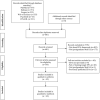The logic behind entrustable professional activity frameworks: A scoping review of the literature
- PMID: 35388517
- PMCID: PMC9542438
- DOI: 10.1111/medu.14806
The logic behind entrustable professional activity frameworks: A scoping review of the literature
Abstract
Introduction: Entrustable professional activities (EPAs), discrete profession-specific tasks requiring integration of multiple competencies, are increasingly used to help define and inform curricula of specialty training programmes. Although guidelines exist to help guide the developmental process, deciding what logic to use to draft a preliminary EPA framework poses a crucial but often difficult first step. The logic of an EPA framework can be defined as the perspective used by its developers to break down the practice of a profession into units of professional work. This study aimed to map dominant logics and their rationales across postgraduate medical education and fellowship programmes.
Methods: A scoping review using systematic searches within five electronic databases (Medline, Embase, Google Scholar, Scopus and Web of Science) was performed. Dominant logics of included papers were identified using inductive coding and iterative analysis.
Results: In total, 42 studies were included. Most studies were conducted in the United States (n = 22; 52%), Canada (n = 6; 14%) and the Netherlands (n = 4; 10%). Across the reported range of specialties, family medicine (n = 4; 10%), internal medicine (n = 4; 10%), paediatrics (n = 3; 7%) and psychiatry (n = 3; 7%) were the most common. Three dominant logics could be identified, namely, 'service provision', 'procedures' and/or 'disease or patient categories'. The majority of papers (n = 37; 88%) used two or more logics when developing EPA frameworks (median = 3, range = 1-4). Disease or patient groups and service provision were the most common logics used (39% and 37%, respectively).
Conclusions: Most programmes used a combination of logics when trying to capture the essential tasks of a profession in EPAs. For each of the three dominant logics, the authors arrived at a definition and identified benefits, limitations and examples. These findings may potentially inform best practice guidelines for EPA development.
© 2022 The Authors. Medical Education published by Association for the Study of Medical Education and John Wiley & Sons Ltd.
Conflict of interest statement
We know of no conflicts of interest associated with this publication.
Figures
Comment in
-
Struggling with the logic of EPA frameworks.Med Educ. 2022 Sep;56(9):868-870. doi: 10.1111/medu.14846. Epub 2022 Jun 6. Med Educ. 2022. PMID: 35619052 No abstract available.
References
Publication types
MeSH terms
LinkOut - more resources
Full Text Sources
Research Materials


